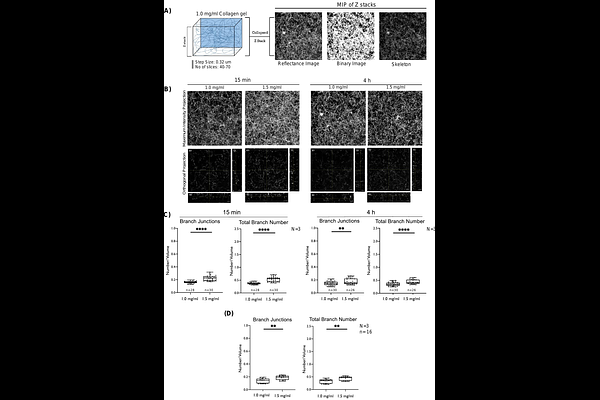Caveolin-1 dependent regulation of cell-matrix interphase in 3D collagen gels.

Caveolin-1 dependent regulation of cell-matrix interphase in 3D collagen gels.
Mazumdar, D.; Kataria, S.; Panda, G. P.; Kulkarni, A.; Patil, S. P. V.; Dash, M.; Balasubramanian, N.
AbstractCell and extracellular matrix (ECM) interactions are essential for maintaining tissue function and homeostasis. Changes in the biochemical or mechanical properties of the ECM can lead to diseases such as fibrosis or cancer. In a 3D microenvironment, cell-matrix interaction is vital to how cells sense and respond to biochemical and biophysical cues. This study examines the reciprocal interactions between fibroblasts and collagen in 3D hydrogels. We quantitatively measured changes in collagen branch number and junctions in 3D hydrogels using confocal reflectance microscopy and existing analysis protocols. This reveals the impact small changes in collagen concertation (1.0 vs 1.5 mg/ml) over time (15 minutes to 4 hours) have on 3D gels. Embedded in 3D hydrogels, wild-type mouse fibroblasts differentially affect collagen organisation in their immediate proximity with changing concentration and time. This regulation is interestingly lost in Caveolin-1 null fibroblasts with altered stiffness, mechanosensing and cytoskeletal regulation. Inhibition of the Rho-ROCK pathway (known to be changed in Caveolin-1 null fibroblasts) drives cellular protrusions and concentration- dependent 3D collagen organisation in wildtype fibroblasts, but surprisingly not in Caveolin- 1 null fibroblasts. This depends on dynamin-dependent endocytosis, which, when inhibited, disrupts ROCK-dependent protrusions and alters collagen organisation in 3D collagen. Together, these observations quantitatively demonstrate how cells respond at the cell-matrix interphase to subtle changes in collagen concentration and organisation in 3D hydrogels, regulated by the presence of Caveolin-1.